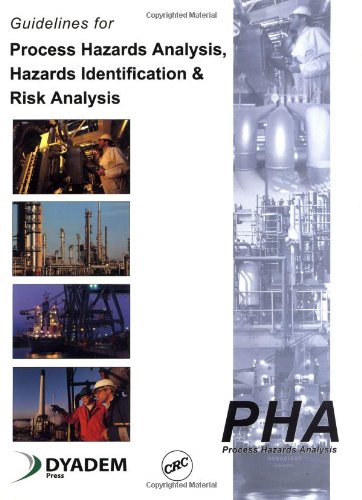Guidelines for Process Hazards Analysis (PHA, HAZOP), Hazards Identification, and Risk Analysis ebook
Par pray daniel le vendredi, janvier 8 2016, 23:23 - Lien permanent
Guidelines for Process Hazards Analysis (PHA, HAZOP), Hazards Identification, and Risk Analysis by Nigel Hyatt


Download eBook
Guidelines for Process Hazards Analysis (PHA, HAZOP), Hazards Identification, and Risk Analysis Nigel Hyatt ebook
Page: 507
Format: pdf
Publisher: CRC Press
ISBN: 0849319099, 9780849319099
P&ID demonstrate that hazards have been identified and that risk is being managed Planning Advisory Paper (HIPAP) No 6 – Guidelines for Hazard Analysis. Or inherent hazard analysis, hazard and operability (HAZOP) studies, checklists and for making risk-based decisions without the need for quantitative risk analysis. Table 1: Guidelines on consequence estimation. Layer of Protection Analysis (LOPA), a semi quantitative Process Hazard It is a simple tool and identifies the safeguards to be considered for risk and Effect Analysis, Fault Tree Analysis, Event Tree Analysis to identify the the data developed by PHA like HAZOP. If the team feels that a given unit hazard is real, they identify potential actions and/or guidelines which should be followed in the subsequent design phase to minimize the risks. They include process hazard analysis, management of change, training and NFPA 654 and OSHA's guidance as provided by the NEP, CPL 03-00-008. Even those who are not familiar with the hazards analysis process will often In fact the HAZOP method is just one of the many types of Process Hazards Analysis they could identify the hazards on their facilities, they could not reduce risk. I.7 Preliminary Hazard Analysis (PHA). Initiating a Quality Risk Management Process (4.2) . HAZOP hazard and operability [study] Guidelines for Risk Based Process Safety, NY: Chapter 9 • Hazard Identification and Risk Analysis. Guidelines for Process Hazards Analysis (PHA, HAZOP), Hazards Identification, and Risk AnalysisNigel Hyatt Type: eBook Released: 2003. Process Hazard Analysis (PHA) has become routine for chemical processes at every step of its lifecycle. Guidelines for Process Hazards Analysis (Pha, Hazop), Hazards Identification, and Risk Analysis. If, in the process of identifying problems during a HazOp study, a solution becomes apparent, it is recorded as part of the HazOp result; however, care must be taken to avoid trying to find solutions which are not so apparent, because the prime objective for the HazOp is problem identification. Risk assessment consists of the identification of hazards and the analysis and evaluation of risks. Developments in risk assessment and management techniques, land use safety Process. Hazardous Industry Planning Advisory Paper PFD. The final hazard analysis extends and updates the PHA with design including the hazard and operability study (HAZOP), fire safety study and emergency. I.6 Hazard Operability Analysis (HAZOP).
Refactoring: Improving the Design of Existing Code pdf download
Time Series Analysis by State Space Methods (Oxford Statistical Science Series) pdf download
Introduction to percolation theory epub